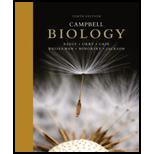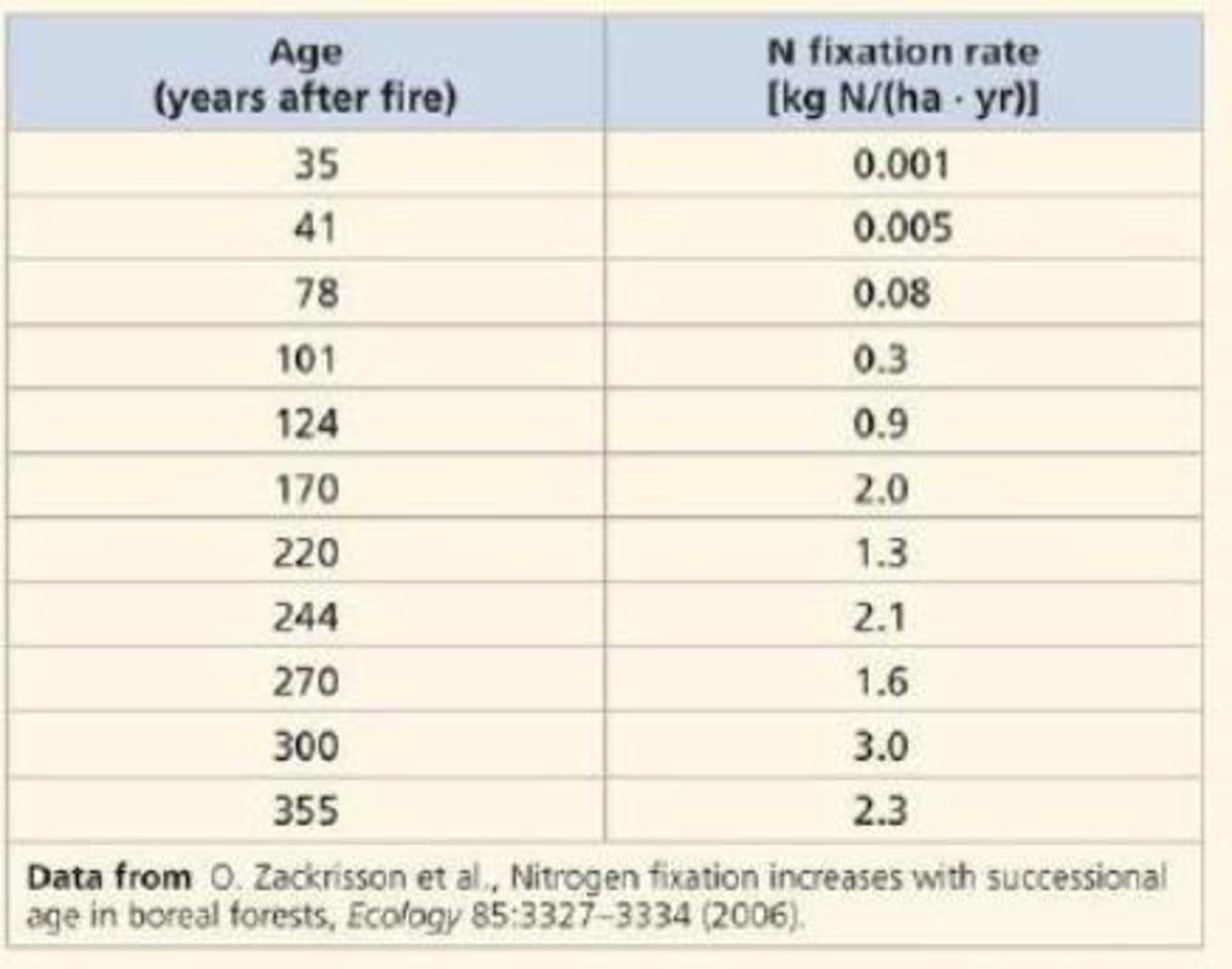
Concept explainers
SCIENTIFIC INQUIRY
INTERPRET THE DATA Ihe feather moss Pleurozium schreberi harbors species of symbiotic nitrogen-fixing bacteria. Scientists studying this moss in northern forests found that the percentage of the ground surface“covered” by the moss increased from about 5% in forests that burned 35 to 41 years ago to about 70% in forests that burned 170 or more years ago From mosses growing in these forests, they also obtained the following data on nitrogen fixation:

(a) Use the data to draw a line graph, with age on the x-axis and the nitrogen fixation rate on the y-axis.
(B) Along with the nitrogen added by nitrogen fixation, about 1kg of nitrogen per hectare per year is deposited into northern forests from the atmosphere as rain and small particles. Evaluate the extent to which Pleurozium affects nitrogen availability in northern forests of different ages.
Want to see the full answer?
Check out a sample textbook solution
Chapter 29 Solutions
Campbell Biology (10th Edition)
- Figure 44.21 In which of the following regions would you expect to find photosynthetic organisms? the aphotic zone, the meritic zone, the oceanic zone, and the benthic realm the photic zone, the intertidal zone, the meritic zone, and the oceanic zone the photic zone, the abyssal zone, the meritic zone, and the oceanic zone the pelagic realm. the aphotic zone, the meritic zone, and the oceanic zonearrow_forwardINTERPRET DATA Examine Figure 56-24. How many of the sampled species are found in the nonserpentine soil? in the serpentine soil? in the ecotone? What generalization about ecotones do these data support? RESULTS AND CONCLUSION: The various plant species found in the two communities (yellow and blue) and in the ecotone between them (green) are shown in the graph. The ecotone had a greater richness than either adjoining community. SOURCE: Modified from C.D. White, VegetationSoil Chemistry Correlations in Serpentine Ecosystems, Ph.D. dissertation (University of Oregon, Eugene, 1971). Reprinted with permission of Dr. Charles D. White. Figure 56-24 Ecotones and species richness Note that the two fescues in the figure are different species.arrow_forwardEVOLUTION LINK The number of protonephridia in a planarian is related to the salinity of its environment. Planaria inhabiting slightly salty water develop fewer protonephridia than those inhabiting less salty water, but the number of protonephridia quickly increases when the concentration of salt in the environment is lower. How is this increase adaptive? Explain.arrow_forward
- How would loss of fungi in a forest effect biogeochemical cycles in the area? a. Nitrogen could no longer be fixed into organic molecules. b. Phosphorus stores would be released for use by other organisms. c. Sulfur release from eroding rocks would cease. d. Carbon would accumulate in dead organic matter and waste.arrow_forwardStream orders 1 and 2 are generally shaded by tree canopy overhanging the streams. If you cleared the trees light will reach the stream. Why don't we see phytoplankton colonizing this site?arrow_forwardWhich of these occurs through symbiotic nitrogen fixation? a. The plant benefits from using an endless source of nitrogen. b. The soil benefits from being naturally fertilized. c. Bacteria benefit from using photosynthates from the plant. d. All of the above occur.arrow_forward
- The blue-green bacteria (also called cyanobacteria) in some lichens are capable of nitrogen fixation. Why would this be especially advantageous in early stages of ecological succession?arrow_forwardIn shallow coastal ecosystems dominated by seagrasses, nutrients limit primary production under low nutrient (oligotrophic) condition while light becomes the limiting factor under high nutrient (eutrophic) condition. In the conceptual model given below, identify which group of primary producers (i.e. seagrasses, macroalgae, phytoplankton) corresponds to each of the line graphs by filling in the blank boxes. Explain your answer.arrow_forwardit is discovered that the algae-killing product (AlgaeBdead) that spilled in Lake Ontario also inhibits (slows) the growth of fungi in the lake. Explain one way this would negatively affect the lake ecosystem.arrow_forward
- In a seagrass ecosystem, nutrients limit primary production under low nutrient (oligotrophic) condition, while light becomes the limiting factor under high nutrient (eutrophic) condition. Discuss how this happens with respect to the three primary producers (seagrass, macroalgae, phytoplankton) as the condition changes from oligotrophic to eutrophic.arrow_forwardyou have a plant that is struggling to survive. after closer examination you notice tiny red mites all over your plant. which symbiotic relationship is likely occurring between the plants and the mites? explainarrow_forwardLike plants,_______ have chlorophylls a and b. a. diatoms c. green algae b. red algae d. giant kelpsarrow_forward
 Biology (MindTap Course List)BiologyISBN:9781337392938Author:Eldra Solomon, Charles Martin, Diana W. Martin, Linda R. BergPublisher:Cengage Learning
Biology (MindTap Course List)BiologyISBN:9781337392938Author:Eldra Solomon, Charles Martin, Diana W. Martin, Linda R. BergPublisher:Cengage Learning Biology 2eBiologyISBN:9781947172517Author:Matthew Douglas, Jung Choi, Mary Ann ClarkPublisher:OpenStax
Biology 2eBiologyISBN:9781947172517Author:Matthew Douglas, Jung Choi, Mary Ann ClarkPublisher:OpenStax
 Biology Today and Tomorrow without Physiology (Mi...BiologyISBN:9781305117396Author:Cecie Starr, Christine Evers, Lisa StarrPublisher:Cengage Learning
Biology Today and Tomorrow without Physiology (Mi...BiologyISBN:9781305117396Author:Cecie Starr, Christine Evers, Lisa StarrPublisher:Cengage Learning



